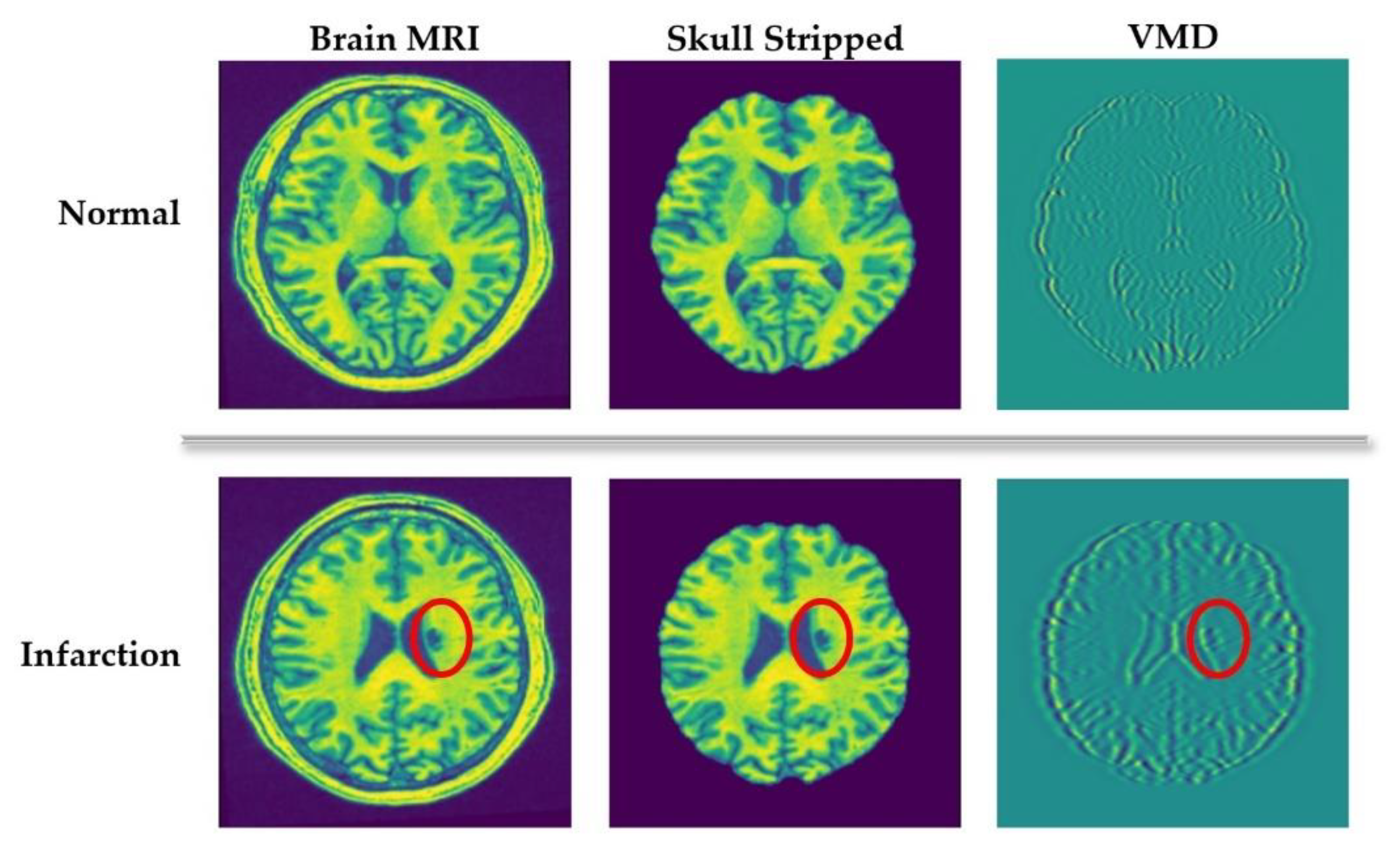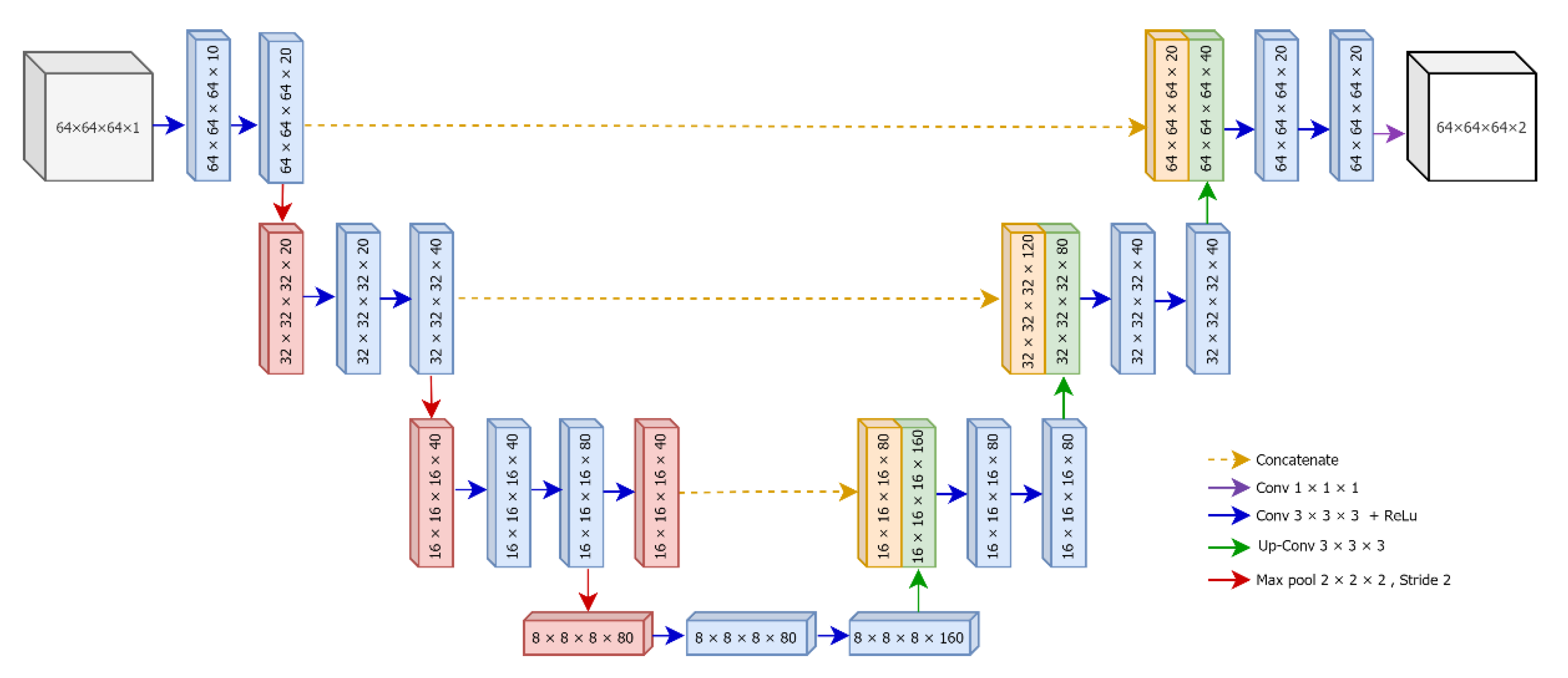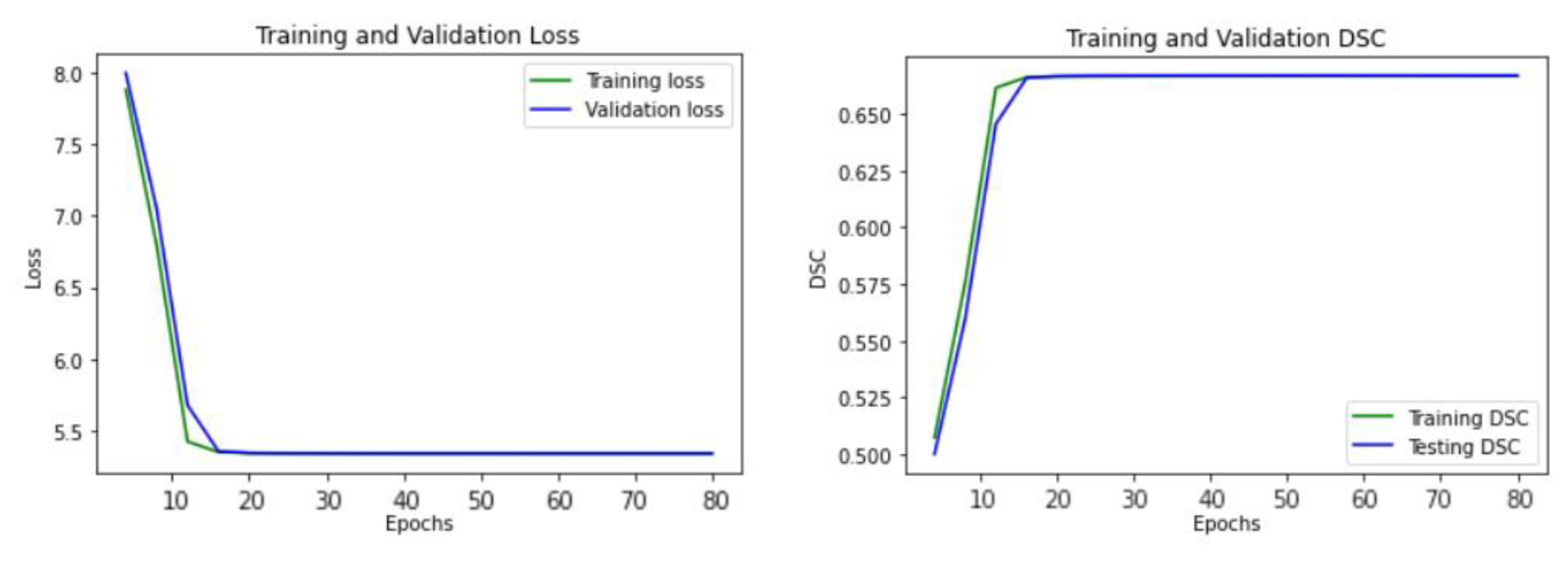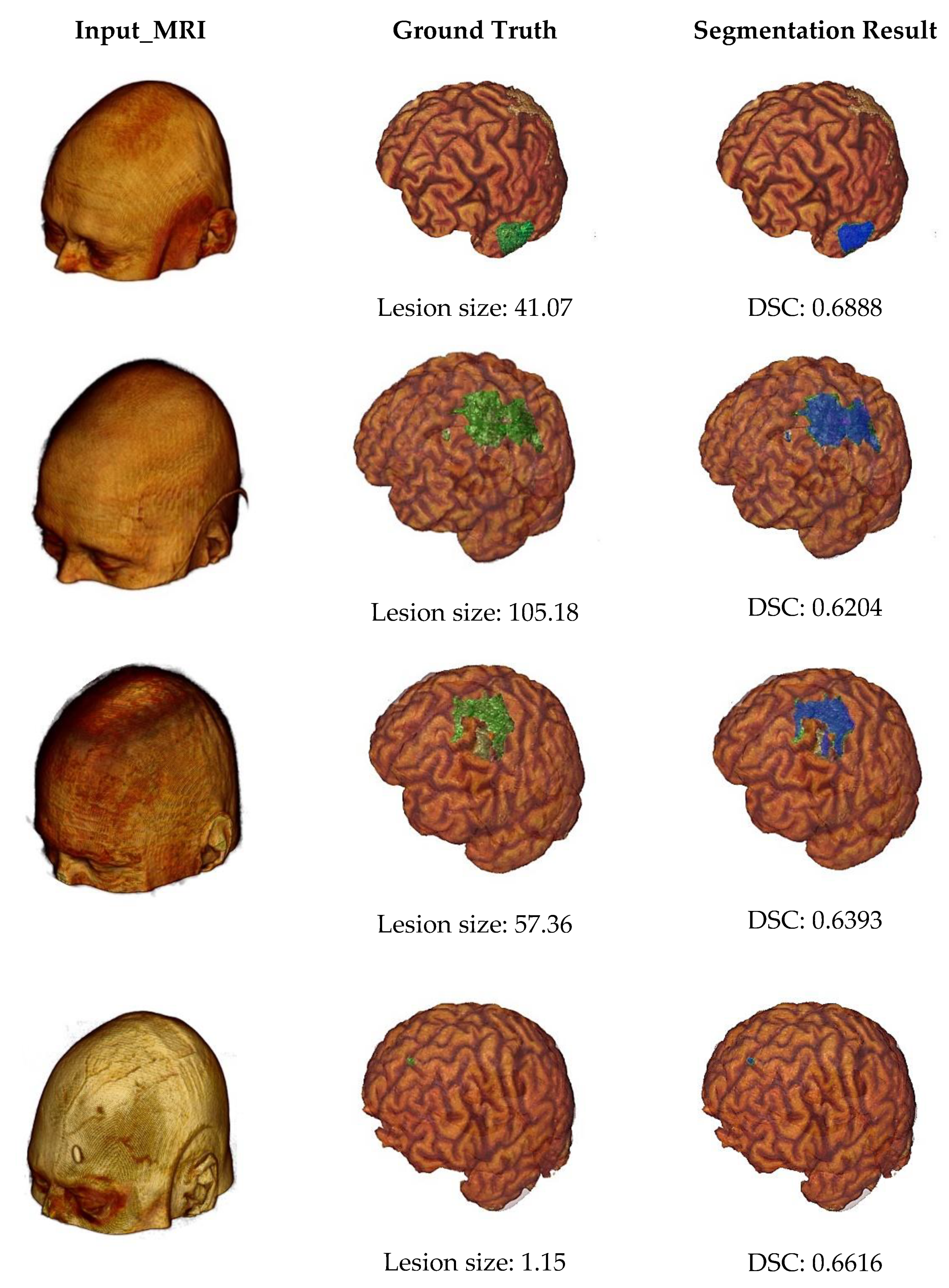Automated Segmentation of Infarct Lesions in T1-Weighted MRI Scans Using Variational Mode Decomposition and Deep Learning
Abstract
1. Introduction
2. Related Works
- (i)
- For the first contribution, we proposed variational mode decomposition (VMD) as a preprocessing task. It helps remove non-infarct tissues from the input MRI scans and lessens the amount of unwanted information from the input volumes.
- (ii)
- For the second contribution, we presented overlapped patches strategy, which divides the input MRI volumes into smaller patches. The divided patches were fed into the U-Net model to perform patch-wise segmentation. The proposed overlapped patch strategy also performed patch pruning to reduce the workload of the segmentation model. Moreover, it records the reference numbers of patches aiming at seamless and intensive postprocessing.
- (iii)
- For the last contribution, we developed a three-dimensional U-Net model for the segmentation of infarct lesions from volumetric patches. Then, a postprocessing was followed in order to produce the final segmentation results.
3. Materials and Methods
3.1. Overview of the Proposed Method
3.2. Data Source
3.3. Variational Mode Decomposition (VMD)
3.4. Overlapped Patches Strategy
3.5. Three-Dimensional U-Net (3D U-Net)
4. Results and Discussion
4.1. Configurations of the Proposed Method
4.1.1. Data Preparation
4.1.2. Preprocessing
- Skull Stripping
- Variational mode decomposition (VMD)
- Overlapped Patches Strategy
4.1.3. Segmentation Using 3D U-Net
4.1.4. Postprocessing
4.2. Results
- Jaccard similarity coefficient (IoU)
- Dice similarity coefficient (DSC)
- Average symmetric surface distance (ASSD)
| Algorithm 1. Pseudo Code for Proposed Infarct Lesion Segmentation | |
| Input: | Brain MRI exams as S = {s1, s2, …., sn}, and associated ground truth masks as M = {m1, m2, …., mn}, where n is the total number of exams in the given dataset. |
| Step 1: | Prepare the data for training, validation, and testing. Assign 60% of the given dataset for training, 20% for validation, and 20% for testing. n_train = n ∗ (60/100) n_val = n ∗ (20/100) n_test = n ∗ (20/100) Divide S and M into training split. Strain = {s1, s2, …., sn_train} Mtrain = {m1,m2,…,mn_train} Divide S and M into validation split. Sval = {sn_train +1, sn_train +2, …., sn_train + n_val} Mval = {mn_train +1, mn_train +2, …., mn_train + n_val} Divide S and M into testing split. Stest = {sn_train+n_val +1, sn_train+n_val+2, …., sn_train+ n_val+ n_test} Mtest = {mn_train+n_val +1, mn_train+n_val+2, …., mn_train+ n_val+ n_test} |
| Step 2: | Perform preprocessing of the input MRI exams. Perform skull-stripping using DeepBrain. DeepBrain (Strain, Sval, Stest) return Strain_stripped, Sval_stripped, Stest_stripped Perform variational mode decomposition of skull-stripped exams. VMD (Strain_stripped, Sval_stripped, Stest_stripped) return Strain_vmd, Sval_vmd, Stest_vmd Divide the decomposed exams and associated ground truths into overlapped patches. Overlapped Patches (Strain_vmd, Sval_vmd, Stest_vmd, Mtrain, Mval, Mtest) return Strain_patches, Sval_patches, Stest_patches Mtrain_patches, Mval_patches, Mtest_patches |
| Step 3: | Develop 3D U-Net model based on the desired architecture. |
| Step 4: | Train the U-Net model using Strain_patches, Sval_patches, Mtrain_patches, Mval_patches. |
| Step 5: | Test the trained U-Net using Stest and perform postprocessing. |
| Step 6: | Evaluate the performance of U-Net using Mtest. |
| Output: | Segmented infarct lesions of tested MRIs and assessment measurements. |
4.3. Discussion
5. Conclusions
Author Contributions
Funding
Data Availability Statement
Acknowledgments
Conflicts of Interest
References
- Gorelick, P.B. The Global Burden of Stroke: Persistent and Disabling. Lancet Neurol. 2019, 18, 417–418. [Google Scholar] [CrossRef]
- Kim, J.; Thayabaranathan, T.; Donnan, G.A.; Howard, G.; Howard, V.J.; Rothwell, P.M.; Feigin, V.; Norrving, B.; Owolabi, M.; Pandian, J.; et al. Global Stroke Statistics 2019. Int. J. Stroke 2020, 15, 819–838. [Google Scholar] [CrossRef] [PubMed]
- Liew, S.-L.; Anglin, J.M.; Banks, N.W.; Sondag, M.; Ito, K.L.; Kim, H.; Chan, J.; Ito, J.; Jung, C.; Khoshab, N.; et al. A Large, Open Source Dataset of Stroke Anatomical Brain Images and Manual Lesion Segmentations. Sci. Data 2018, 5, 180011. [Google Scholar] [CrossRef] [PubMed]
- Kwon, S.; Hartzema, A.G.; Duncan, P.W.; Min-Lai, S. Disability Measures in Stroke: Relationship Among the Barthel Index, the Functional Independence Measure, and the Modified Rankin Scale. Stroke 2004, 35, 918–923. [Google Scholar] [CrossRef]
- Mohd, A.; Kipli, K.; Hamdi, M.; Jobli, A.; Sahari, S.; Muhammad, M.; Chong, S.K.; Kharabsheh, B. A Review of MRI Acute Ischemic Stroke Lesion Segmentation. IJIE 2020, 12, 117–127. [Google Scholar] [CrossRef]
- Gudigar, A.; Raghavendra, U.; Ciaccio, E.J.; Arunkumar, N.; Abdulhay, E.; Acharya, U.R. Automated Categorization of Multi-Class Brain Abnormalities Using Decomposition Techniques With MRI Images: A Comparative Study. IEEE Access 2019, 7, 28498–28509. [Google Scholar] [CrossRef]
- Fiez, J.A.; Damasio, H.; Grabowski, T.J. Lesion Segmentation and Manual Warping to a Reference Brain: Intra- and Interobserver Reliability. Hum. Brain Mapp. 2000, 9, 192–211. [Google Scholar] [CrossRef]
- Maier, O.; Schröder, C.; Forkert, N.D.; Martinetz, T.; Handels, H. Classifiers for Ischemic Stroke Lesion Segmentation: A Comparison Study. PLoS ONE 2015, 10, e0145118. [Google Scholar] [CrossRef] [PubMed]
- Griffis, J.C.; Allendorfer, J.B.; Szaflarski, J.P. Voxel-Based Gaussian Naïve Bayes Classification of Ischemic Stroke Lesions in Individual T1-Weighted MRI Scans. J. Neurosci. Methods 2016, 257, 97–108. [Google Scholar] [CrossRef]
- Maier, O.; Wilms, M.; von der Gablentz, J.; Krämer, U.; Handels, H. Ischemic Stroke Lesion Segmentation in Multi-Spectral MR Images with Support Vector Machine Classifiers. In Proceedings of the SPIE Medical Imaging, San Diego, CA, USA, 24 March 2014; Volume 9035, p. 903504. [Google Scholar] [CrossRef]
- Rajendra Acharya, U.; Meiburger, K.M.; Faust, O.; En Wei Koh, J.; Lih Oh, S.; Ciaccio, E.J.; Subudhi, A.; Jahmunah, V.; Sabut, S. Automatic Detection of Ischemic Stroke Using Higher Order Spectra Features in Brain MRI Images. Cogn. Syst. Res. 2019, 58, 134–142. [Google Scholar] [CrossRef]
- Mitra, J.; Bourgeat, P.; Fripp, J.; Ghose, S.; Rose, S.; Salvado, O.; Connelly, A.; Campbell, B.; Palmer, S.; Sharma, G.; et al. Lesion Segmentation from Multimodal MRI Using Random Forest Following Ischemic Stroke. NeuroImage 2014, 98, 324–335. [Google Scholar] [CrossRef]
- Pustina, D.; Coslett, H.B.; Turkeltaub, P.E.; Tustison, N.; Schwartz, M.F.; Avants, B. Automated Segmentation of Chronic Stroke Lesions Using LINDA: Lesion Identification with Neighborhood Data Analysis: LINDA: Auto-Segmentation of Stroke Lesions. Hum. Brain Mapp. 2016, 37, 1405–1421. [Google Scholar] [CrossRef] [PubMed]
- Subudhi, A.; Jena, S.S.; Sabut, S. Automated Detection of Brain Stroke in MRI with Hybrid Fuzzy C-Means Clustering and Random Forest Classifier. Int. J. Comp. Intel. Appl. 2019, 18, 1950018. [Google Scholar] [CrossRef]
- Ali, F.; El-Sappagh, S.; Islam, S.M.R.; Kwak, D.; Ali, A.; Imran, M.; Kwak, K.-S. A Smart Healthcare Monitoring System for Heart Disease Prediction Based on Ensemble Deep Learning and Feature Fusion. Inf. Fusion 2020, 63, 208–222. [Google Scholar] [CrossRef]
- Dawud, A.M.; Yurtkan, K.; Oztoprak, H. Application of Deep Learning in Neuroradiology: Brain Haemorrhage Classification Using Transfer Learning. Comput. Intell. Neurosci. 2019, 2019, 4629859. [Google Scholar] [CrossRef] [PubMed]
- Suberi, A.A.M.; Nurshazwani, W.; Tomari, R.; Nazari, A.; Norzali, M.; Farhan, N. Deep Transfer Learning Application for Automated Ischemic Classification in Posterior Fossa CT Images. IJACSA 2019, 10. [Google Scholar] [CrossRef]
- Jung, S.-M.; Whangbo, T.-K. A Deep Learning System for Diagnosing Ischemic Stroke by Applying Adaptive Transfer Learning. J. Internet Technol. 2020, 21, 1957–1968. [Google Scholar]
- Kamnitsas, K.; Ledig, C.; Newcombe, V.F.J.; Simpson, J.P.; Kane, A.D.; Menon, D.K.; Rueckert, D.; Glocker, B. Efficient Multi-Scale 3D CNN with Fully Connected CRF for Accurate Brain Lesion Segmentation. Med. Image Anal. 2017, 36, 61–78. [Google Scholar] [CrossRef]
- Zhou, Y.; Huang, W.; Dong, P.; Xia, Y.; Wang, S. D-UNet: A Dimension-Fusion U Shape Network for Chronic Stroke Lesion Segmentation. IEEE Acm. Trans. Comput. Biol. Bioinf. 2019. [Google Scholar] [CrossRef]
- Qi, K.; Yang, H.; Li, C.; Liu, Z.; Wang, M.; Liu, Q.; Wang, S. X-Net: Brain Stroke Lesion Segmentation Based on Depthwise Separable Convolution and Long-Range Dependencies. In Medical Image Computing and Computer Assisted Intervention—MICCAI 2019; Shen, D., Liu, T., Peters, T.M., Staib, L.H., Essert, C., Zhou, S., Yap, P.-T., Khan, A., Eds.; Lecture Notes in Computer Science; Springer: Cham, Switzerland, 2019; Volume 11766, pp. 247–255. [Google Scholar] [CrossRef]
- Yang, H.; Huang, W.; Qi, K.; Li, C.; Liu, X.; Wang, M.; Zheng, H.; Wang, S. CLCI-Net: Cross-Level Fusion and Context Inference Networks for Lesion Segmentation of Chronic Stroke. In Medical Image Computing and Computer Assisted Intervention—MICCAI 2019; Shen, D., Liu, T., Peters, T.M., Staib, L.H., Essert, C., Zhou, S., Yap, P.-T., Khan, A., Eds.; Lecture Notes in Computer Science; Springer: Cham, Switzerland, 2019; Volume 11766, pp. 266–274. [Google Scholar] [CrossRef]
- Liu, L.; Kurgan, L.; Wu, F.-X.; Wang, J. Attention Convolutional Neural Network for Accurate Segmentation and Quantification of Lesions in Ischemic Stroke Disease. Med. Image Anal. 2020, 65, 101791. [Google Scholar] [CrossRef] [PubMed]
- Xue, Y.; Farhat, F.G.; Boukrina, O.; Barrett, A.M.; Binder, J.R.; Roshan, U.W.; Graves, W.W. A Multi-Path 2.5 Dimensional Convolutional Neural Network System for Segmenting Stroke Lesions in Brain MRI Images. Neuroimage Clin. 2020, 25, 102118. [Google Scholar] [CrossRef] [PubMed]
- Tomita, N.; Jiang, S.; Maeder, M.E.; Hassanpour, S. Automatic Post-Stroke Lesion Segmentation on MR Images Using 3D Residual Convolutional Neural Network. Neuroimage Clin. 2020, 27, 102276. [Google Scholar] [CrossRef] [PubMed]
- Lahmiri, S. Image Characterization by Fractal Descriptors in Variational Mode Decomposition Domain: Application to Brain Magnetic Resonance. Phys. A: Stat. Mech. Its Appl. 2016, 456, 235–243. [Google Scholar] [CrossRef]
- Dragomiretskiy, K.; Zosso, D. Two-Dimensional Variational Mode Decomposition. In Energy Minimization Methods in Computer Vision and Pattern Recognition; Tai, X.-C., Bae, E., Chan, T.F., Lysaker, M., Eds.; Lecture Notes in Computer Science; Springer: Cham, Switzerland, 2015; Volume 8932, pp. 197–208. [Google Scholar] [CrossRef]
- Ronneberger, O.; Fischer, P.; Brox, T. U-Net: Convolutional Networks for Biomedical Image Segmentation. In Medical Image Computing and Computer Assisted Intervention—MICCAI 2015; Navab, N., Hornegger, J., Wells, W., Frangi, A., Eds.; Lecture Notes in Computer Science; Springer: Cham, Switzerland, 2015; Volume 9351, pp. 234–241. [Google Scholar] [CrossRef]
- Deepbrain. Available online: Https://Pypi.Org./Project/Deepbrain/ (accessed on 11 October 2020).
- Yeghiazaryan, V.; Voiculescu, I. Family of Boundary Overlap Metrics for the Evaluation of Medical Image Segmentation. J. Med. Imaging 2018, 5, 1. [Google Scholar] [CrossRef] [PubMed]







| Partitions | Number of Scans | Subject ID | Number of Lesions |
|---|---|---|---|
| Training | 143 | c0003 to c0007 (c0007s0020t01) | 268 |
| Validation | 48 | c0007 (c0007s0021t01) to c0010(c0010s0009t01) | 88 |
| Testing | 48 | c0010(c0010s0009t02) to c0011(c0011s0015t01) | 74 |
| Names of the Hyperparameters | Selected Values |
|---|---|
| Bandwidth constraint ( | 1000 |
| Number of modes () | 5 |
| Lagrangian multipliers dual ascent time step () | 0.5 |
| Tolerance () | K × 10−6 |
| Estimated mode center-frequencies () | 1 |
| Names of the Hyperparameters | Selected Values |
|---|---|
| Batch size | 16 |
| Drop-out rate | 0.2 |
| Learning rate | 0.001 |
| Number of iterations (Epochs) | 20 |
| Optimizer | Adam |
| Loss function | Dice loss |
| Assessment Measures | Mean (Std) Values |
|---|---|
| Intersection over Union (IoU) | 0.5022 (±0.0206) |
| Dice similarity coefficient (DSC) | 0.6684 (±0.0187) |
| Average symmetric surface distance (ASSD) | 0.3932 (±0.1475) |
| Method | X-Net [21] | (CLCI-Net) [22] | 2.5D CNN [24] | D-UNet [20] | 3D-Res-UNet [25] | Proposed Method |
|---|---|---|---|---|---|---|
| Data Source | ATLAS | ATLAS | KF & MCW (Train) ATLAS (Test) | ATLAS | ATLAS | ATLAS |
| Number of Samples | 229 | 220 | 99 (54 from ATLAS) | 229 | 239 | 239 |
| Data Split Ratio (Train, validation, test) | 5-fold cross validation | 55, 18, 27 | 100 for testing | 80, 20, 0 | 76, 11, 13 | 60, 20, 20 |
| Input size (Height × Width × Depth) | 192 × 224 × 1 | 176 × 233 × 1 | 192 × 224 × 192 | 192 × 4 × 192 | 144 × 172 × 168 | 197 × 233 × 189 |
| Base Architecture | 2D U-Net | 2D U-Net | 2.5D U-Net | 3D U-Net | 3D U-Net | 3D U-Net |
| Loss function | Dice loss, cross-entropy | Dice loss | Dice loss | Dice loss, focal loss | Dice loss, cross-entropy | Dice loss |
| Reported DSC | 0.49 | 0.58 | 0.54 | 0.54 | 0.64 | 0.6684 * |
Publisher’s Note: MDPI stays neutral with regard to jurisdictional claims in published maps and institutional affiliations. |
© 2021 by the authors. Licensee MDPI, Basel, Switzerland. This article is an open access article distributed under the terms and conditions of the Creative Commons Attribution (CC BY) license (http://creativecommons.org/licenses/by/4.0/).
Share and Cite
Paing, M.P.; Tungjitkusolmun, S.; Bui, T.H.; Visitsattapongse, S.; Pintavirooj, C. Automated Segmentation of Infarct Lesions in T1-Weighted MRI Scans Using Variational Mode Decomposition and Deep Learning. Sensors 2021, 21, 1952. https://doi.org/10.3390/s21061952
Paing MP, Tungjitkusolmun S, Bui TH, Visitsattapongse S, Pintavirooj C. Automated Segmentation of Infarct Lesions in T1-Weighted MRI Scans Using Variational Mode Decomposition and Deep Learning. Sensors. 2021; 21(6):1952. https://doi.org/10.3390/s21061952
Chicago/Turabian StylePaing, May Phu, Supan Tungjitkusolmun, Toan Huy Bui, Sarinporn Visitsattapongse, and Chuchart Pintavirooj. 2021. "Automated Segmentation of Infarct Lesions in T1-Weighted MRI Scans Using Variational Mode Decomposition and Deep Learning" Sensors 21, no. 6: 1952. https://doi.org/10.3390/s21061952
APA StylePaing, M. P., Tungjitkusolmun, S., Bui, T. H., Visitsattapongse, S., & Pintavirooj, C. (2021). Automated Segmentation of Infarct Lesions in T1-Weighted MRI Scans Using Variational Mode Decomposition and Deep Learning. Sensors, 21(6), 1952. https://doi.org/10.3390/s21061952








